Rapid Optical Biosensing of SARS-CoV-2 Spike Proteins in Artificial Samples
Abstract
:1. Introduction
2. Experimental Section
2.1. Materials
2.2. Bioconjugation of Monoclonal Antibody (mAb)
2.3. Comparison of AMEC and DAB for Use as Signal Enhancers in the FO-BLI Biosensors
2.4. Establishing an AMEC-Based FO-BLI Biosensor for ECD and RBD Detection in Buffer and Artificial Samples
2.5. Establishing an AMEC-Based FO-BLI Biosensor for ECD and RBD Detection in Buffer and Artificial Samples
2.6. Data Analysis
3. Results
3.1. Comparison of AMEC and DAB Based FO-BLI Biosensors for SARS-CoV-2 ECD Detection
3.2. Pre-Clinical Validation of the AMEC Based FO-BLI Biosensors for Rapid SARS-CoV-2 Spike Protein
3.3. AMEC-Based FO-BLI Biosensor for Detecting SARS-CoV-2 RBD and ECD in Spiked Saliva and Saliva
3.4. Characterization of AMEC Generated Precipitate for Signal Enhancement in FO-BLI Biosensors
4. Discussion
Author Contributions
Funding
Institutional Review Board Statement
Informed Consent Statement
Data Availability Statement
Acknowledgments
Conflicts of Interest
References
- V’Kovski, P.; Kratzel, A.; Steiner, S.; Stalder, H.; Thiel, V. Coronavirus biology and replication: Implications for SARS-CoV-2. Nat. Rev. Microbiol. 2021, 19, 155–170. [Google Scholar] [CrossRef] [PubMed]
- Wu, A.; Peng, Y.; Huang, B.; Ding, X.; Wang, X.; Niu, P.; Meng, J.; Zhu, Z.; Zhang, Z.; Wang, J.; et al. Genome Composition and Divergence of the Novel Coronavirus (2019-nCoV) Originating in China. Cell Host Microbe 2020, 27, 325–328. [Google Scholar] [CrossRef] [PubMed] [Green Version]
- Matsuyama, S.; Nao, N.; Shirato, K.; Kawase, M.; Saito, S.; Takayama, I.; Nagata, N.; Sekizuka, T.; Katoh, H.; Kato, F.; et al. Enhanced isolation of SARS-CoV-2 by TMPRSS2-expressing cells. Proc. Natl. Acad. Sci. USA 2020, 117, 7001–7003. [Google Scholar] [CrossRef] [PubMed] [Green Version]
- Simmons, G.; Zmora, P.; Gierer, S.; Heurich, A.; Pöhlmann, S. Proteolytic activation of the SARS-coronavirus spike protein: Cutting enzymes at the cutting edge of antiviral research. Antivir. Res. 2013, 100, 605–614. [Google Scholar] [CrossRef] [PubMed]
- Hoffmann, M.; Kleine-Weber, H.; Schroeder, S.; Krüger, N.; Herrler, T.; Erichsen, S.; Schiergens, T.S.; Herrler, G.; Wu, N.H.; Nitsche, A.; et al. SARS-CoV-2 Cell Entry Depends on ACE2 and TMPRSS2 and Is Blocked by a Clinically Proven Protease Inhibitor. Cell 2020, 181, 271–280.e8. [Google Scholar] [CrossRef] [PubMed]
- Seo, G.; Lee, G.; Kim, M.J.; Baek, S.-H.; Choi, M.; Ku, K.B.; Lee, C.-S.; Jun, S.; Park, D.; Kim, H.G.; et al. Rapid Detection of COVID-19 Causative Virus (SARS-CoV-2) in Human Nasopharyngeal Swab Specimens Using Field-Effect Transistor-Based Biosensor. ACS Nano 2020, 14, 5135–5142. [Google Scholar] [CrossRef] [Green Version]
- Yakoh, A.; Pimpitak, U.; Rengpipat, S.; Hirankarn, N.; Chailapakul, O.; Chaiyo, S. Paper-based electrochemical biosensor for diagnosing COVID-19: Detection of SARS-CoV-2 antibodies and antigen. Biosens. Bioelectron. 2021, 176, 112912. [Google Scholar] [CrossRef] [PubMed]
- Pinals, R.L.; Ledesma, F.; Yang, D.; Navarro, N.; Jeong, S.; Pak, J.E.; Kuo, L.; Chuang, Y.-C.; Cheng, Y.-W.; Sun, H.-Y.; et al. Rapid SARS-CoV-2 Spike Protein Detection by Carbon Nanotube-Based Near-Infrared Nanosensors. Nano Lett. 2021, 21, 2272–2280. [Google Scholar] [CrossRef] [PubMed]
- Chen, C.; Wang, J. Optical biosensors: An exhaustive and comprehensive review. Analyst 2020, 145, 1605–1628. [Google Scholar] [CrossRef] [PubMed]
- Amouzadeh Tabrizi, M.; Acedo, P. Highly Sensitive RNA-Based Electrochemical Aptasensor for the Determination of C-Reactive Protein Using Carbon Nanofiber-Chitosan Modified Screen-Printed Electrode. Nanomaterials 2022, 12, 415. [Google Scholar] [CrossRef] [PubMed]
- Cennamo, N.; Pasquardini, L.; Arcadio, F.; Lunelli, L.; Vanzetti, L.; Carafa, V.; Altucci, L.; Zeni, L. SARS-CoV-2 spike protein detection through a plasmonic D-shaped plastic optical fiber aptasensor. Talanta 2021, 233, 122532. [Google Scholar] [CrossRef] [PubMed]
- Awada, C.; Abdullah, M.M.; Traboulsi, H.; Dab, C.; Alshoaibi, A. SARS-CoV-2 Receptor Binding Domain as a Stable-Potential Target for SARS-CoV-2 Detection by Surface—Enhanced Raman Spectroscopy. Sensors 2021, 21, 4617. [Google Scholar] [CrossRef] [PubMed]
- Bian, S.; Shang, M.; Sawan, M. Rapid biosensing SARS-CoV-2 antibodies in vaccinated healthy donors. Biosens. Bioelectron. 2022, 204, 114054. [Google Scholar] [CrossRef] [PubMed]
- Bian, S.; Tao, Y.; Zhu, Z.; Zhu, P.; Wang, Q.; Wu, H.; Sawan, M. On-Site Biolayer Interferometry-Based Biosensing of Carbamazepine in Whole Blood of Epileptic Patients. Biosensors 2021, 11, 516. [Google Scholar] [CrossRef] [PubMed]
- Zhu, Q.; Zhou, X. A colorimetric sandwich-type bioassay for SARS-CoV-2 using a hACE2-based affinity peptide pair. J. Hazard. Mater. 2022, 425, 127923. [Google Scholar] [CrossRef] [PubMed]
- Hadi, M.U.; Khurshid, M. SARS-CoV-2 Detection Using Optical Fiber Based Sensor Method. Sensors 2022, 22, 751. [Google Scholar] [CrossRef] [PubMed]
- Agarwal, D.K.; Nandwana, V.; Henrich, S.E.; Josyula, V.P.V.N.; Thaxton, C.S.; Qi, C.; Simons, L.M.; Hultquist, J.F.; Ozer, E.A.; Shekhawat, G.S.; et al. Highly sensitive and ultra-rapid antigen-based detection of SARS-CoV-2 using nanomechanical sensor platform. Biosens. Bioelectron. 2022, 195, 113647. [Google Scholar] [CrossRef] [PubMed]
- Qiu, G.; Gai, Z.; Tao, Y.; Schmitt, J.; Kullak-Ublick, G.A.; Wang, J. Dual-Functional Plasmonic Photothermal Biosensors for Highly Accurate Severe Acute Respiratory Syndrome Coronavirus 2 Detection. ACS Nano 2020, 14, 5268–5277. [Google Scholar] [CrossRef] [Green Version]
- Cennamo, N.; D’Agostino, G.; Perri, C.; Arcadio, F.; Chiaretti, G.; Parisio, E.M.; Camarlinghi, G.; Vettori, C.; Di Marzo, F.; Cennamo, R.; et al. Proof of Concept for a Quick and Highly Sensitive On-Site Detection of SARS-CoV-2 by Plasmonic Optical Fibers and Molecularly Imprinted Polymers. Sensors 2021, 21, 1681. [Google Scholar] [CrossRef]
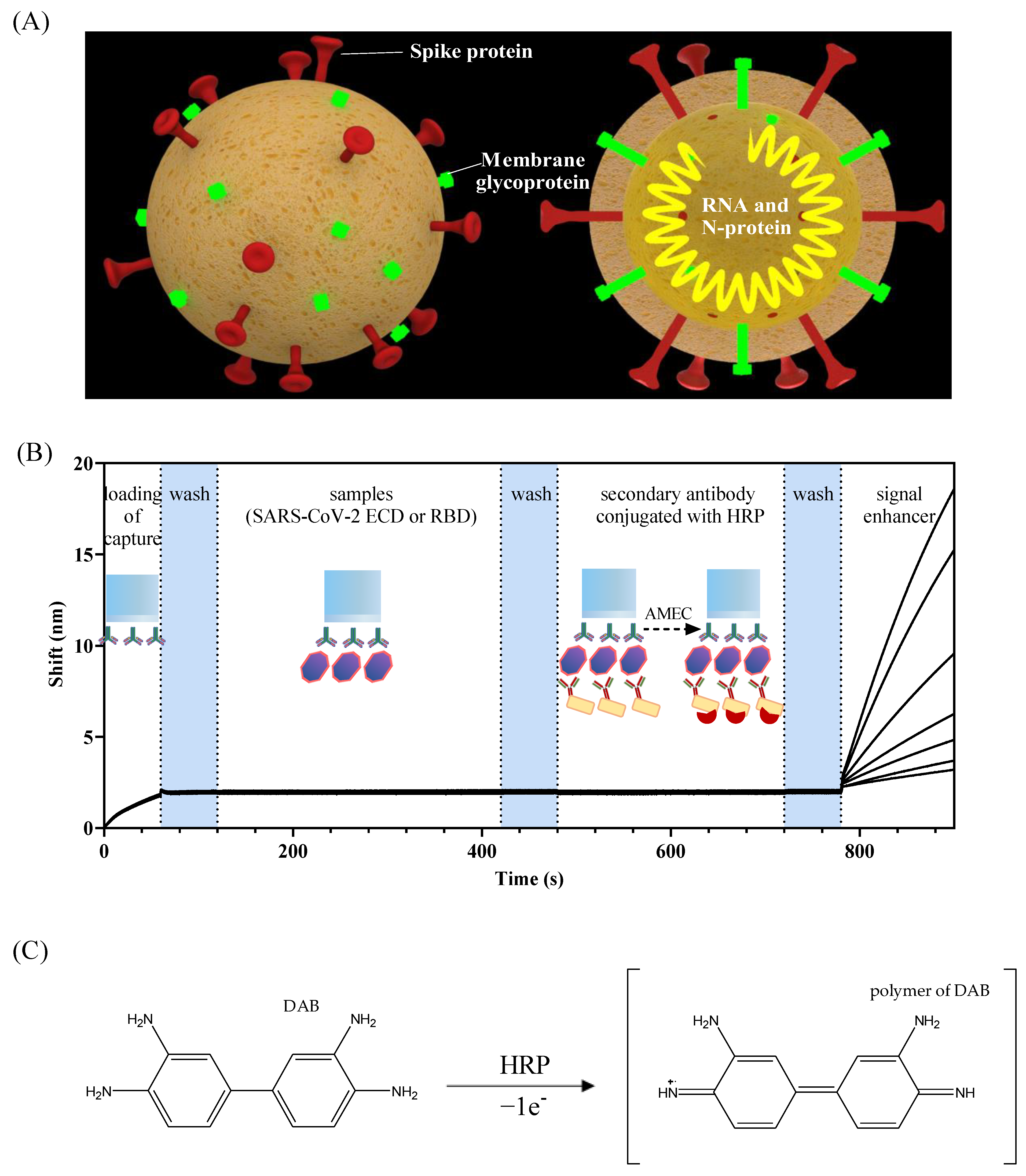
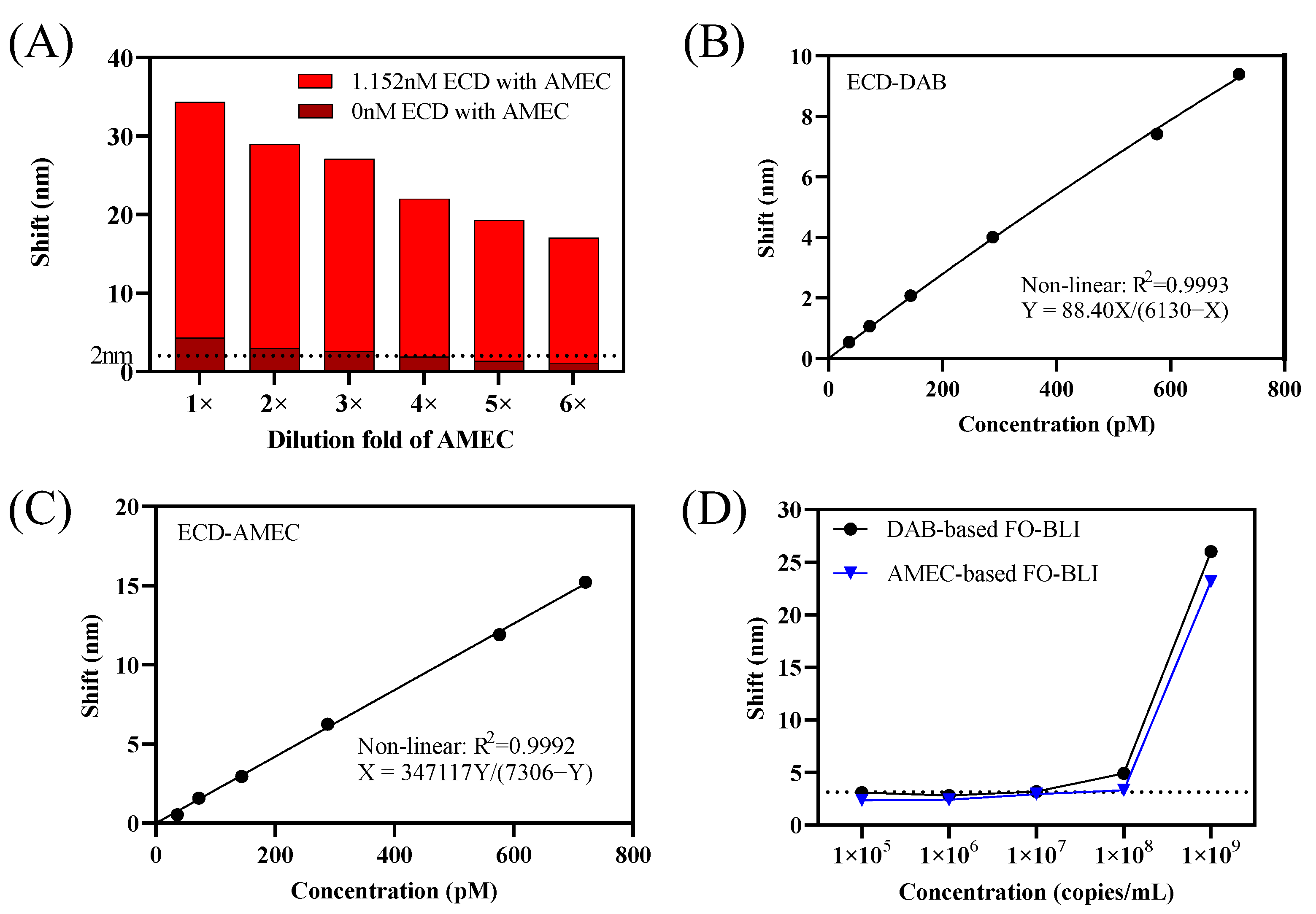
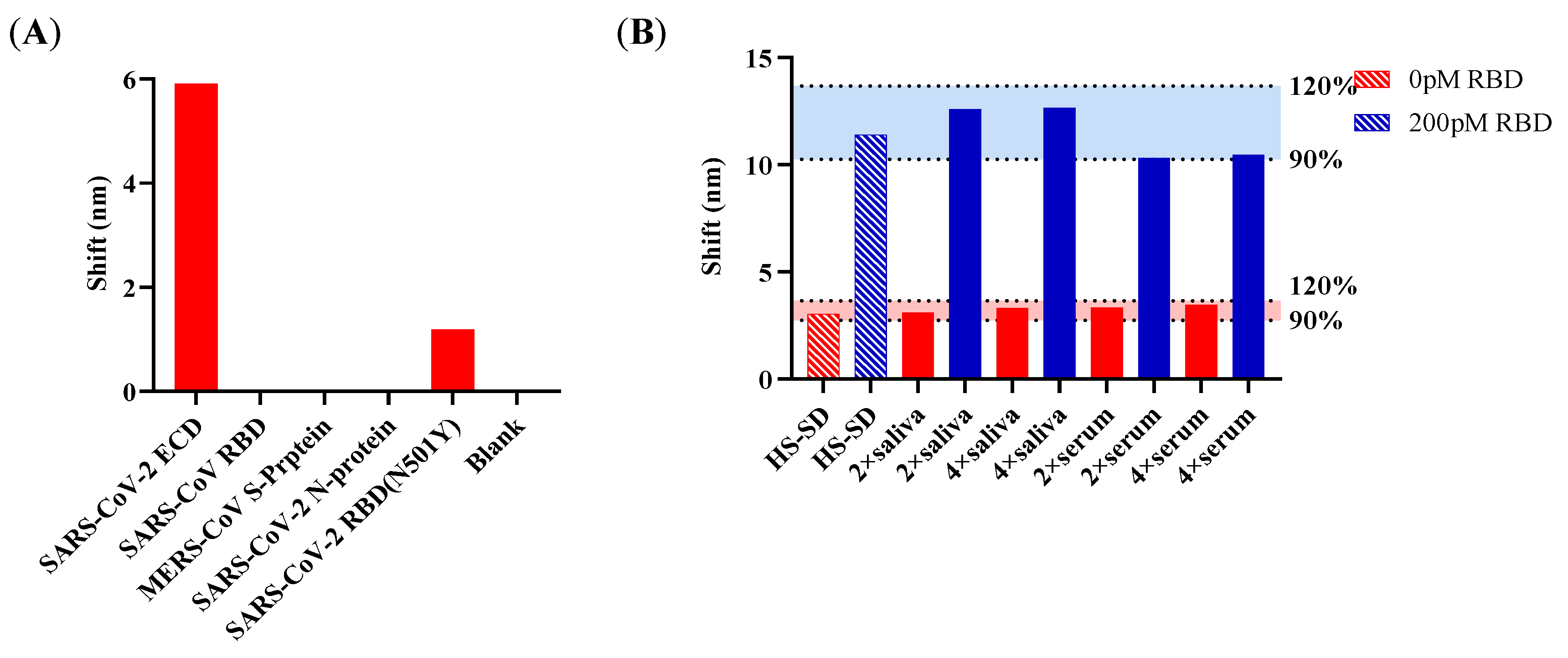
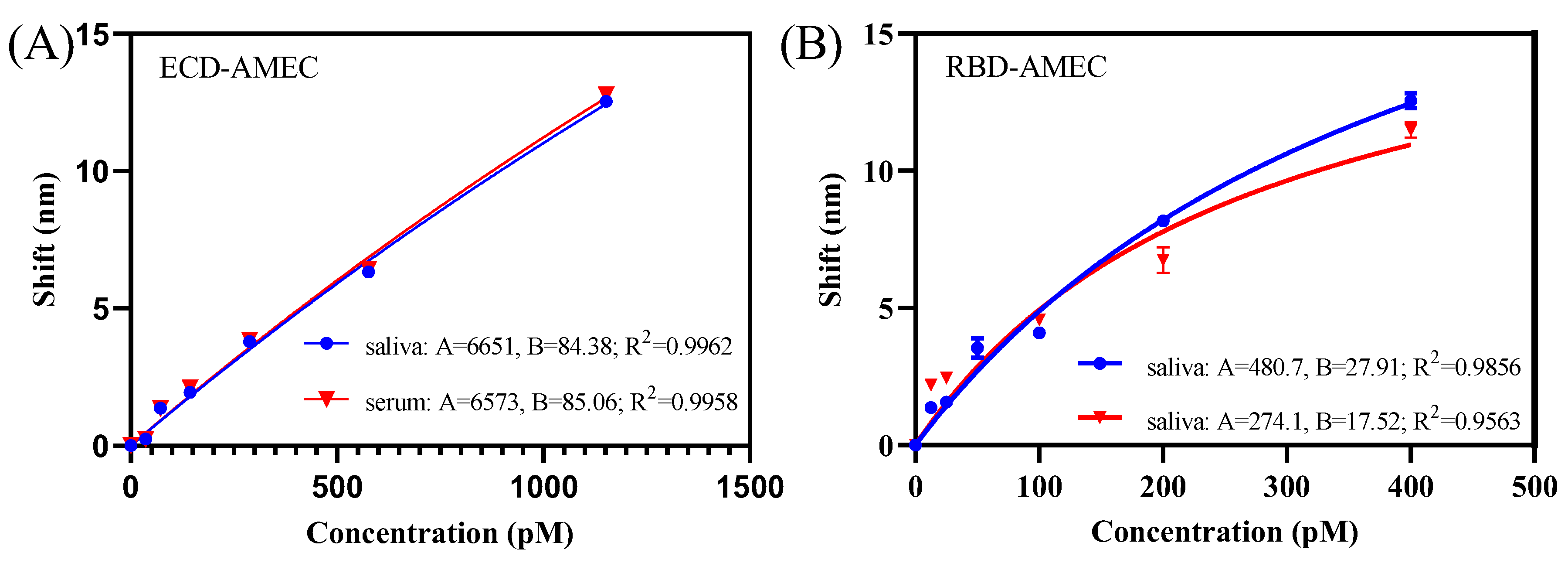
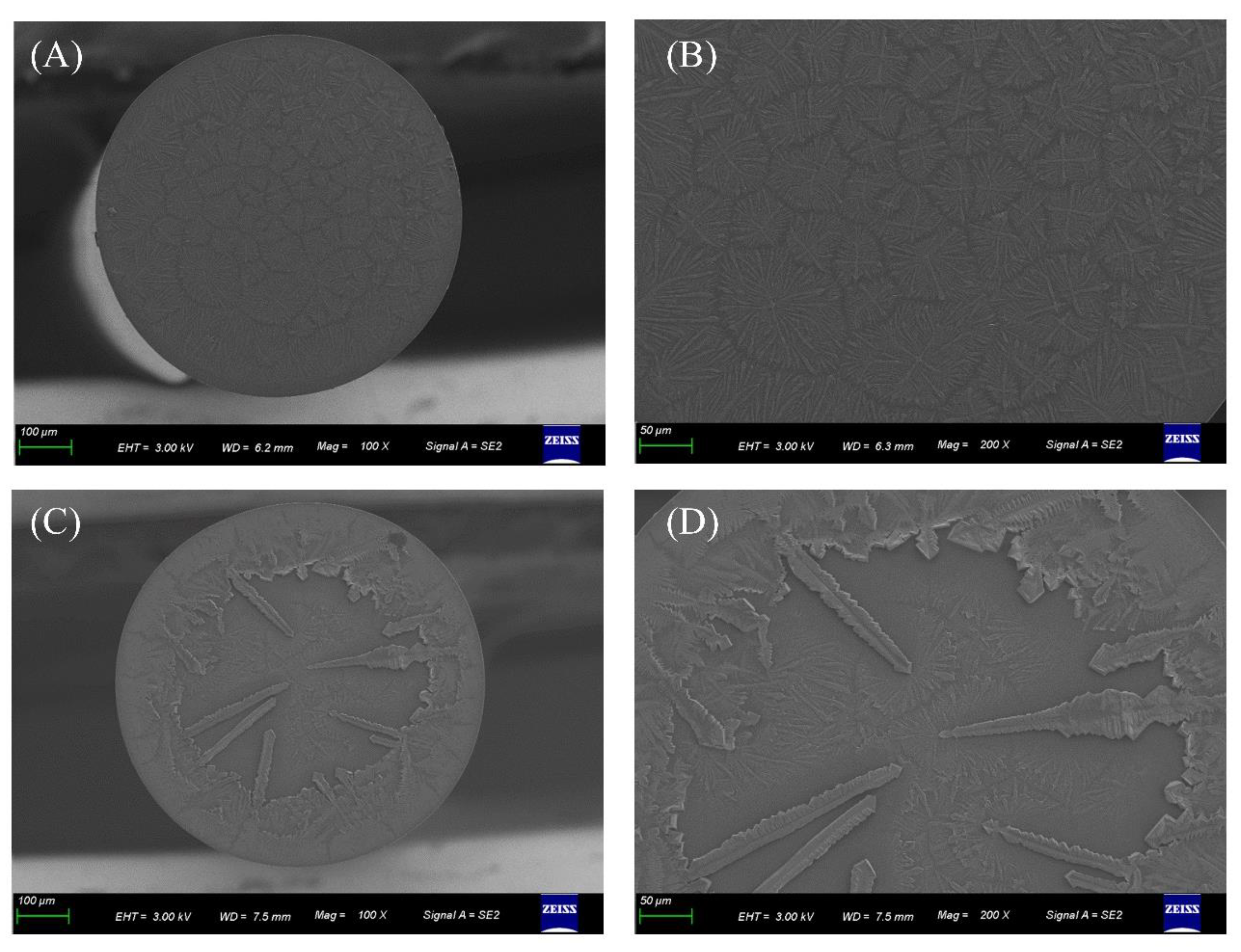
| Items | AMEC Based FO-BLI Biosensor | DAB Based FO-BLI Biosensor |
|---|---|---|
| Signal enhancer | AMEC | DAB |
| Detection range for ECD in buffer | 36–720 pM | 36–720 pM |
| LoD for pseudovirus | 6 × 107 | 2 × 107 |
| Sample-to-result time | 13 min | 13 min |
| Signal-to-noise ratio | 14.6 | 7.4 |
| Stability of enhancer solution | Up to 14 days | 30 min |
| Color of precipitate | Red | Brown |
| Environmental and human friendliness |
|
|
| Solubility of precipiate |
|
|
| Target | Recognition Element | Analytical Sensitivity (LoD) | Time | Substrate | Signal Transducer | Automated | Ref. |
|---|---|---|---|---|---|---|---|
| RBD | ACE2 | 12.5 nM | 5 s | Carbon Nanotube | Near-Infrared | No | [8] |
| RBD | Aptamer | 37 nM | 10 min | D-shaped plastic fiber | SPR | No | [11] |
| RBD | Antibody | 1 pM | 3 s | Au/Ag nanostructures | Surface-enhanced Raman spectroscopy | No | [12] |
| RBD | ACE2 | 10 pM | 30 min | Gold nanoparticles | Colorimetric sandwich bioassay | No | [15] |
| Omicron | Antibody | More sensitive than PCR | 15 min | Plastic fiber | Refractive index variation | No | [16] |
| RBD | Antibody | 33 pM | 5 min | Gold | Microcantilever | No | [17] |
| SARS-CoV-2 sequences | Aptamer | 0.22 pM | >25 min | 2D gold nanoislands | LSPR | No | [18] |
| S protein | MIP | 58,000 pM | 10 min | D-shaped plastic fiber | SPR | No | [19] |
| RBD, ECD | Antibody | 12.5 pM, 36 pM | 13 min | Optical fiber | BLI | Yes | This work |
Publisher’s Note: MDPI stays neutral with regard to jurisdictional claims in published maps and institutional affiliations. |
© 2022 by the authors. Licensee MDPI, Basel, Switzerland. This article is an open access article distributed under the terms and conditions of the Creative Commons Attribution (CC BY) license (https://creativecommons.org/licenses/by/4.0/).
Share and Cite
Tao, Y.; Bian, S.; Wang, P.; Zhang, H.; Bi, W.; Zhu, P.; Sawan, M. Rapid Optical Biosensing of SARS-CoV-2 Spike Proteins in Artificial Samples. Sensors 2022, 22, 3768. https://doi.org/10.3390/s22103768
Tao Y, Bian S, Wang P, Zhang H, Bi W, Zhu P, Sawan M. Rapid Optical Biosensing of SARS-CoV-2 Spike Proteins in Artificial Samples. Sensors. 2022; 22(10):3768. https://doi.org/10.3390/s22103768
Chicago/Turabian StyleTao, Ying, Sumin Bian, Pengbo Wang, Hongyong Zhang, Wenwen Bi, Peixi Zhu, and Mohamad Sawan. 2022. "Rapid Optical Biosensing of SARS-CoV-2 Spike Proteins in Artificial Samples" Sensors 22, no. 10: 3768. https://doi.org/10.3390/s22103768








